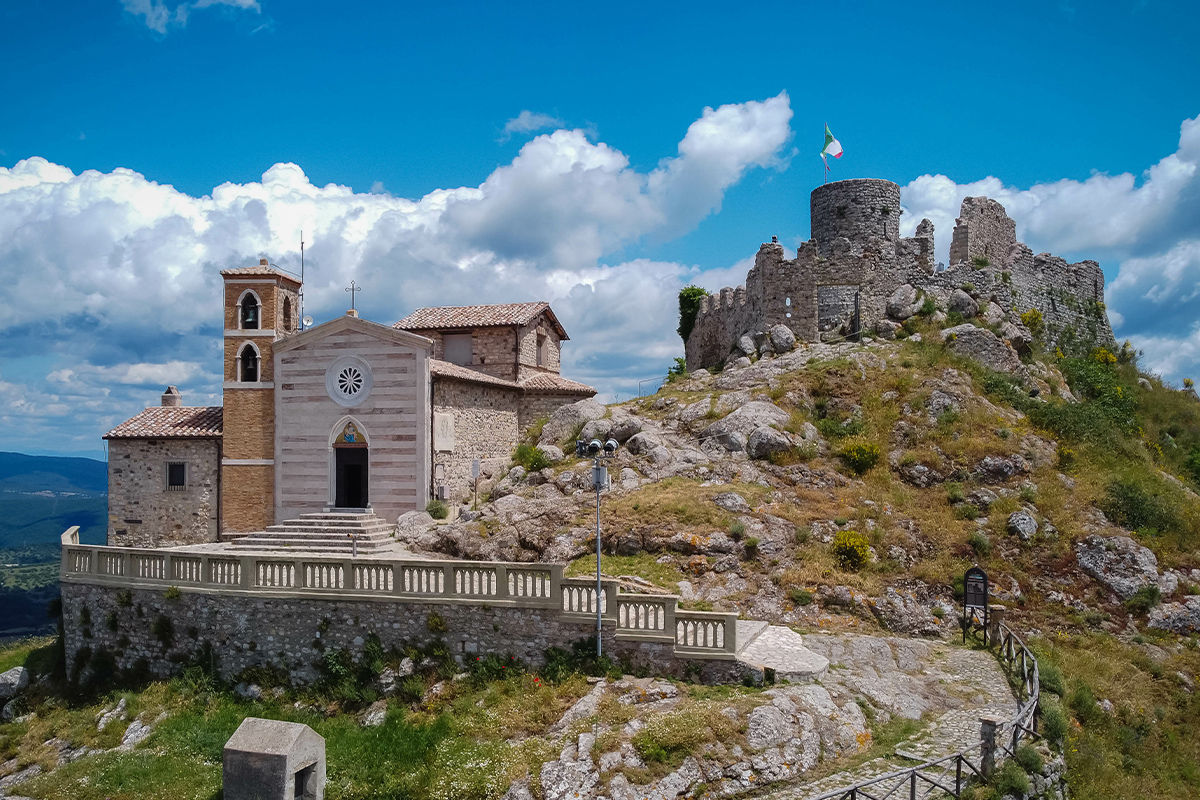The Frangipane Fortress in Tolfa
The Frangipane Fortress and the Sanctuary of Madonna della Rocca: history, art and curiosities.On the top of the splendid Medieval village of Tolfa, there are the remains of the Castle of the Fortress, built by will of the Frangipane family, who took up residence in the Tolfa territory in the fourteenth century AD.
Via della Rocca, the completely uphill street leading to the top of the hill, is particularly suggestive. Throught the tiny streets of the old village of Tolfa, you will easily get to the top, surrounded by charming gardens from the neighboring houses.
We can guarantee that once at the top, the astonishing views you will have in front of you, will make you forget the hustle and your sweaty fronthead!
BOOK TOLFA TOUR (SHOPPING AND TASTING)

Via della Rocca - Tolfa
Via della Rocca, the characteristic tiny street leading to the remains of the castel, was awarded the first place in the contest to choose the most beautiful street of the historic center in 2014, organised by Tolfa City Council.
A LITTLE BIT OF HISTORY
The history of the Fortress is inevitably linked to that of Tolfa. Initially thought as a castle abode of the Frangipane family, over time, thanks to its dominant position took both the functions of control tower and shooting range, hosting even a small cemetery during the nineteenth century.
Tolfa grew around a fortress in the year 1000. From an act of submission in Corneto (actual Tarquinia) it seems that the castle and the surrounding village were called Tolfavecchia or Tulfa Veteris, to be distinguished from another neighboring castle called Tolfanova. In 1448, it passed under the propriety of a branch of the Frangipane family, who restored the castle.
In 1461, after the discovery of the neighboring allum mines, the Tolfa territory became object of intense disputes. In 1469 Pope Paul II purchased the whole village and from then, the castellans were appointed by the Pope. At the beginning of the sixteenth century, after a nobleman from Siena called Agostino Chigi robbed the artillery (transfered to Porto Ercole and Talamone) the castle maintenance stopped, with its consequent decay.
Last defensive bastion during many centuries, the Fortress managed to protect the village also from Napoleon army. It resisted, actually, to the invasion of the French in 1798, representing the last defensive stronghold until 14th March 1799 when it was definitely destroyed, together with most of the Medieval houses of the village. Shut among the old castle remains, the Tolfa inhabitants who rebelled against the French invaders were called briganti (bandits).
Today, the castle is presented as a typical Medieval fortress. From the original castle only remain the cylindrical turret, protected in the inside by crenellated walls, and part of the central body that is said to be at least three-storey tall. There is a basement with slits, a big central room on the ground floor, covered by vaults, and supposedly a superior floor, since some marks can be observed in the high part of the outside wall.

The Fortress of Tolfa and the Sanctuary of the Church of the Virgin
THE SANCTUARY OF MADONNA DELLA ROCCA
Next to the Castle there is the small Church of Madonna della Rocca, built with the aim to protect the Tolfa inhabitants from on high. Also called in the past Saint Mary of Arce, the Sanctuary from Medieval origins represents one of the most important symbols of the Tolfa inhabitants, who found shelter there while they showed their devotion to the Virgin.
The Sanctuary has arrived to our days after a number of restoration works. Inside, there is the precious oil painting from the sixteenth century representing the deposition from the Cross, with the Virgin Mary seating, holding his son's corpse, just after being put down the Cross. The work, attributed to the Carracci brothers, prominent painters at the beginning of the Baroque period, authors, among other, of the frescoes series of Palazzo Farnese in Rome.
The imponent marble altar, on the other hand, was designed by Franciscan artist Padre Cosma da Cori, guided by a laic hermit, Friar Giuseppe Catalini, who devoted fifty years of his life (1861-1911) to the maintainance of the Sanctuary. The altar was built with fine materials by two well-known marble artists, Ercole Alliata of Civitavecchia and Luigi Martinelli of Rome.
Friar Giuseppe Catalini contributed as well to the creation of the Sacristy and the Via Matris, formed by seven crosses symbolising the seven sorrows of Mary, and took care as well of the creation of the road and the gate in front of the entry to the church.

The church of Rocca in Tolfa
Useful information
Frangipane Fortress in Tolfa
- HOW TO GET THERE
- Plan your trip from the port of Civitavecchia following our directions:By car- From Rome: drive along the Aurelia State Highway or the highway A12 (Roma - Civitavecchia) until the junction/exit S. Severa then take the county road to Tolfa (23 Km);- From Civitavecchia: drive along the county road Braccianese Claudia towards Allumiere/Tolfa/Bracciano for about 20 Km until Tolfa.By bus- From Rome: take the Cotral line (from Saxa Rubra Station) towards Civitavecchia/Tolfa or towards Bracciano/Tolfa.- From Civitavecchia: we recommend to take the Cotral line at stop Porta Tarquinia/Piazza Vittorio Emanuele/Stazione Ferroviaria towards Allumiere/Tolfa.- From the Port of Civitavecchia we recommend to get to our Information point of Largo della Pace next to the stop Porta Tarquinia, where you will also find our staff ready to welcome you.



 PORT MOBILITY CIVITAVECCHIA
PORT MOBILITY CIVITAVECCHIA












